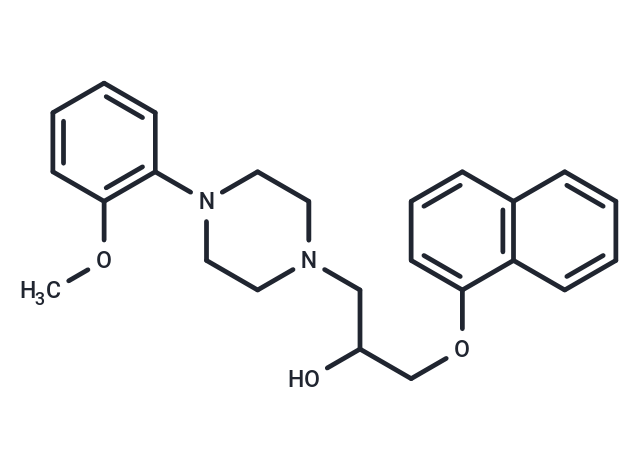Shopping Cart
- Remove All
 Your shopping cart is currently empty
Your shopping cart is currently empty

Naftopidil (KT-611) (INN, marketed under the brand name Flivas), an antihypertensive medicine, is used as a selective α1-adrenergic receptor antagonist or α-blocker.

| Pack Size | Price | Availability | Quantity |
|---|---|---|---|
| 500 mg | $40 | In Stock | |
| 1 g | $64 | In Stock | |
| 1 mL x 10 mM (in DMSO) | $44 | In Stock |
| Description | Naftopidil (KT-611) (INN, marketed under the brand name Flivas), an antihypertensive medicine, is used as a selective α1-adrenergic receptor antagonist or α-blocker. |
| Targets&IC50 | α1B-adrenoceptor:20 nM(Ki), α1A-adrenoceptor:3.7 nM(Ki), α1D-adrenoceptor:1.2 nM(Ki) |
| In vitro | Naftopidil is selective for the alpha1d-adrenoceptor with approximately 3- and 17-fold higher affinity than for the alpha1a- and alpha1b-adrenoceptor subtypes, respectively. [1] Naftopidil has growth inhibitory effect in androgen-sensitive and -insensitive human prostate cancer cell lines. Naftopidil induces p21(cip1) but not p27(kip1) in PC-3 cells. [2] Naftopidil induces apoptosis in all the investigated malignant mesothelioma cells, and a similar effect is obtained with prazosin, another α1-adrenoceptor blocker. Naftopidil-induced reduction in cell viability is inhibited by GF109203X, while prazosin-induced in cell viability is less affected. [3] Naftopidil, an alpha 1-adrenoreceptor antagonist produces a concentration-dependent inhibition ofcollagen-induced Ca2+ mobilization, maximum inhibition (22.9%) occurring with 40 mM Naftopidil. Naftopidil also inhibits the adrenaline-induced rise in [Ca2+]i in a concentration-dependent manner (30 mM doxazosin), significant inhibitions of platelet aggregation also being produced. [4] Naftopidil (0.3, 1, and 3 μM) inhibits 5-HT-induced bladder contraction in a concentration-dependent manner. Naftopidil inhibits both the 5-HT(2A) and 5-HT(2) receptor agonists-induced bladder contractions. Naftopidil binds to the human 5-HT(2A) and 5-HT(2B) receptors with pKi values of 6.55 and 7.82, respectively. [5] |
| In vivo | Naftopidil selectively inhibits the phenylephrine-induced increase in prostatic pressure compared with mean blood pressure in the anesthetized dog model. [1] Naftopidil inhibits 5-HT-induced bladder contraction via blockade of the 5-HT(2A) and 5-HT(2B) receptors in rats. [5] |
| Alias | KT-611, BM-15275 |
| Molecular Weight | 392.49 |
| Formula | C24H28N2O3 |
| Cas No. | 57149-07-2 |
| Smiles | O(CC(CN1CCN(CC1)C2=C(OC)C=CC=C2)O)C=3C4=C(C=CC3)C=CC=C4 |
| Relative Density. | 1.184 g/cm3 |
| Storage | Powder: -20°C for 3 years | In solvent: -80°C for 1 year | Shipping with blue ice. | |||||||||||||||||||||||||||||||||||
| Solubility Information | H2O: < 1 mg/mL (insoluble or slightly soluble) Ethanol: < 1 mg/mL (insoluble or slightly soluble) DMSO: 75 mg/mL (191.09 mM), Sonication is recommended. | |||||||||||||||||||||||||||||||||||
Solution Preparation Table | ||||||||||||||||||||||||||||||||||||
DMSO
| ||||||||||||||||||||||||||||||||||||

Copyright © 2015-2025 TargetMol Chemicals Inc. All Rights Reserved.